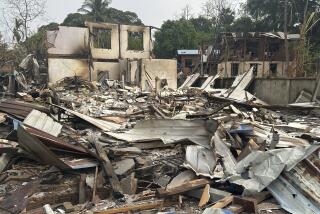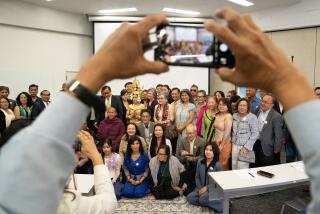ASIA : Khmer Rouge Still a Threat in Cambodia : Guerrillas lost their headquarters to government troops. But they could make a comeback with monsoons.
PHNOM PENH, Cambodia â Despite the loss last month of their headquarters in the gem-mining town of Pailin, the Maoist guerrillas known as the Khmer Rouge still pose a formidable threat to the government in Phnom Penh, according to diplomats here.
Government troops marched into the town, which lies on the border with Thailand, on March 19. It was the first time since 1989 that the town has been back in government hands.
To get there, the Cambodian army had to detour around nearly 20 miles of road--land that has been described as the most heavily mined in the world. The Khmer Rouge has clung tenaciously to their unofficial capital for good reason: The rubies and timber produced in the region put millions of dollars into the movementâs coffers.
The government is now rushing reinforcements into Pailin because the arrival of the annual monsoon rains in a month or two will make the rough-hewn track that now links Pailin with the outside world virtually impassable.
Once the rains come, diplomats say, the governmentâs advantage in tanks and armored cars will disappear, and the battle will be fought on conventional guerrilla terms, which could tip the advantage to the field-hardened Khmer Rouge.
The government has staked its prestige on holding the town, and its loss could represent âanother Dienbienphu,â in the words of King Norodom Sihanouk, referring to Franceâs catastrophic defeat to Vietnamese insurgents in 1954.
Even before the battle at Pailin had begun, the government seized the Khmer Rouge border camp called Anlong Veng in northwestern Cambodia, only to lose it again a week later. That battle showed that the Khmer Rouge has plenty of fight left.
One Western analyst compared fighting the Khmer Rouge to punching a pillow--you create an indentation in one place but the pillow expands into another. After Pailin, the rebels did not surrender but merely dissipated to the north and west. Perhaps this lingering threat helps explain why Hun Sen, one of the governmentâs two prime ministers, called for a cease-fire to mark this weekâs Cambodian New Year celebrations.
Nearly a million Cambodians died from starvation, disease and mistreatment under the Khmer Rouge, which ruled Cambodia from 1975 until 1979. As a result, the group is widely despised but also feared.
The Khmer Rouge refused to cooperate with the U.N. peace effort in Cambodia and boycotted the May, 1993, elections, which resulted in a coalition government in Phnom Penh.
The coalition has produced a new army, said to number about 120,000 men, made up of soldiers from the old Phnom Penh regime and two non-Communist guerrilla groups. The army chief of staff, Gen. Ke Kim Yan, is widely regarded as one of the most able men in the country, and he had the independence to choose an officer of the Khmer Peopleâs National Liberation Front, his former adversary, as his ground commander for the Pailin campaign.
But the government is close to running out of ammunition and has been cut off from virtually all the military aid it received in the past from Russia and Vietnam. Paradoxically, the Khmer Rouge, which tried to implement Maoist economic reforms when it governed Cambodia, has raised considerable cash and has been able to buy plenty of military hardware, spare parts and ammunition on the open market.
A Rebel Escape Hatch
Cambodiaâs Khmer Rouge guerrillas have survived in part, officials say, because Thailand has allowed them to slip across the border to safety.
1. The Khmer Rouge have been flushed from their headquarters in Pailin.
2. The Thais have opened their borders to the Khmer Rouge rebels and do business with them, allowing the group to survive, diplomats said.
More to Read
Sign up for Essential California
The most important California stories and recommendations in your inbox every morning.
You may occasionally receive promotional content from the Los Angeles Times.










